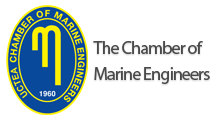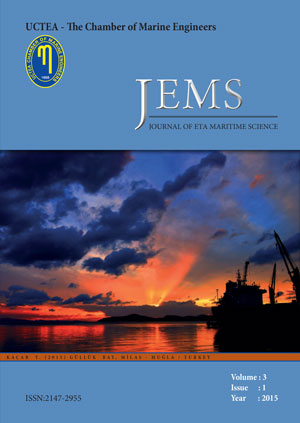

JEMS apply the Creative Commons Attribution NonCommercial 4.0 International Licence to all manuscripts to be published
ABSTRACTING & INDEXING
Volume: 3 Issue: 1 - 2015
| ORIGINAL RESEARCH (AR) | |
| 1. | Human Error in Grounding Accidents: Case Study for Container Ships Umut Yıldırım, Özkan Uğurlu, Ersan Başar doi: 10.5505/jems.2015.57966 Pages 1 - 10 OBJECTIVE: The main purpose of the study was to identify the human error-related causes of marine accidents that involve grounding, and bring solution for these accidents. METHODS: The AHP was used for the analysis of the accident data and the proposed solutions. RESULTS: Preventive measures for grounding accidents on container ships is increasing the number of watch keeping officers, pre-ship and on-ship trainings, bridge resource management applications, the use of lookouts and the use of the ECDIS device. CONCLUSION: In conclusion, it was determined that the measure with the highest priority for preventing grounding accidents with container ships is increasing the number of watch keeping officers. Other measures which were effective for preventing grounding accidents are included pre-joining and on-board trainings, bridge resource management applications practices, the use of lookouts, and, finally, the use of the ECDIS device. |
| FULL TEXT | |
| 2. | Journal of ETA Maritime Science (Volume: 3 Issue: 1, 2015) Pages 1 - 52 Abstract | |
| ORIGINAL RESEARCH (AR) | |
| 3. | Catching the Stars: The Using On Navigation and Extant Examples of Astrolabe Yasemin Nemlioğlu Koca doi: 10.5505/jems.2015.10820 Pages 11 - 22 Astrolabe which was a device used on navigation by navigators until the 18th century, was used in areas such as representing of the various graphical problems, measuring of the altitude angels of the stars, determining of the latitudes, measuring of the time, obtaining information about the zodiac and etc. in astronomy. Astrolabe which was a portable device like a quadrant and used upright on observation, the altitude and positions of the stars and the sun were measured and located by an astrolabe on the horizon. Astrolabe was the most common and best-known device in astronomy and known by the Greeks in the 2ⁿᵈ-4th centuries BC. It can be known that, however it was developed in ancient times, its variations and usage was increased in the Arab-Islamic culture in the 8th-9th centuries.[1] Astrolabe which was learned by Muslims during the period of the Crusades and the Andalusia, was used on the open sea navigation especially by the Spanish and Portuguese navigators thanks to its practical usage about measuring of the latitudes according to the polar altitude. Towards the end of the 15th century, astronomy studies which were developed as a continuation of the Islamic culture in Ottoman were institutionalized and continued in Müneccimbaşılık. The using and producing of astrolabes were continued until the 18th century in muvakkithanes and observatories under this institution.[2] There are protected and extant examples of astrolabes in the various museums in İstanbul. The article aims to study, the principles, usage and extant examples of astrolabe on the İstanbul Topkapı Palace Museum, İstanbul Kandilli Observatory and İstanbul Maritime Museum. |
| 4. | Perceptions of Female and Male Students on Sustainable Maritime Development Concept: A Case Study from Turkey Cemile Solak Fışkın, Durmuş Ali Deveci doi: 10.5505/jems.2015.02486 Pages 23 - 36 INTRODUCTION: OBJECTIVE: It is a fact that maritime transport is essential for achieving sustainable transport development, and the concept of sustainable development has recently raised great interest in maritime industry. The fundamental role in driving and supporting the sustainability should be pursued by young people, and in Turkey as a developing country sustainable maritime development should be specially emphasized by the young population amounting to one third of total. The aim of this paper is to analyze the perceptions of female and male students on sustainable maritime development concept. METHODS: In order to reach this aim, a study was carried out using a questionnaire distributed to maritime faculty students in Turkey. Three pillars of sustainable maritime development were used to reveal how important the issue is for students and how they monitor them. RESULTS: The study indicated strong importance of social sustainable maritime development while the most important driver perceived as one of the environmental item water pollution. DISCUSSION AND CONCLUSION: CONCLUSION: The results of the study reveal not only the perceptional differences between Turkish female and male students on sustainable development concept but also on sources of environmental concerns. |
| 5. | Operational Planning In Ports: A Study On The Present State Of Turkish Ports Hakkı Kişi, Remzi Fışkın, Emre Uçan, Cenk Şakar, Erkan Çakır, Ali Yasin Kaya, Tolga Ahmet Gülcan doi: 10.5505/jems.2015.30074 Pages 37 - 46 OBJECTIVE: In this study, it is aimed to analyze the operational planning process of ports via examining the operational activities implemented by port operators. METHODS: 6 ports which operate in four different regions (Black Sea, Marmara, Aegean, and Mediterranean) in Turkey were selected with convenience sampling method in order to represent the universe of the study. The data obtained via interview techniques were analyzed by using content analysis as a qualitative research method. RESULTS: It has been found that the operational plan meetings has been mainly held with participation of port operation managers, chief and foreman, usually at 10: 00 each morning on the basis of all port or berth. CONCLUSION: According to the results obtained from the research findings, it is revealed that operational planning processes of the ports differ from each other in terms of participators and frequency of meetings, priorities, scope, and concerns. |
| REVIEW (RE) | |
| 6. | Cruise Ship Sewage Treatment Standards and Systems Volkan Şahin, Nurten Vardar doi: 10.5505/jems.2015.58077 Pages 47 - 52 Cruise shipping sector is one of the most important sectors that has a great share in world tourism. This sector, which is getting bigger rapidly, transforms cruise ships into floating cities. The great cruise ships became a serious threat for the seas and oceans by producing wastes by either passengers or operation phase. It is observed that the passenger ships, which have 3000-4000 passenger capacity, discharge a considerable amount of sewage comparing with the other cargo ships. The treatment and discharge procedures of sewage are regulated and inspected by MARPOL and EPA. In this study, the types of sewage treatment systems, working principles, the convenience of treated wastes to national and international standards and the discharge standards of inspection organizations are compared. MSDs (Marine Sanitation Device System) and AWTs (Advanced Wastewater Treatment System), which are used especially on cruise ships, are explained in terms of treatment systems for pathogen, nutrients, chemicals and heavy metals. The efficiency of these systems are compared and the convenience of them to international sewage discharge regulations is investigated. When comparing MSD and AWT systems in terms of treatment procedures and the concentrations of treated wastewater, it is clearly seen that AWT systems are more qualified than MSD systems. EPAs standards, which are stricter than other international rules and monitors the discharges to Alaska waters, make the transition from MSD to AWT inevitable. |










